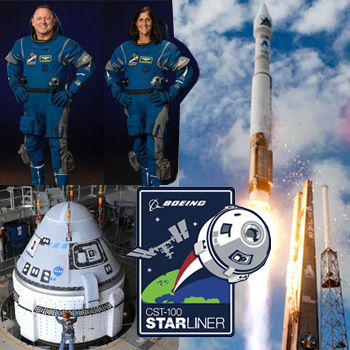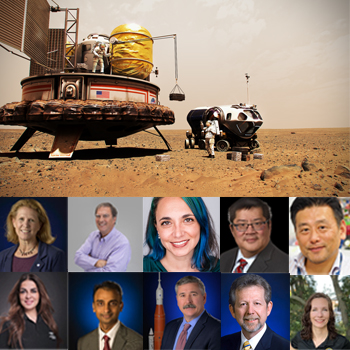Boeing Starliner CST-100 Inaugural Crewed Flight to ISS Set for May 6
United Launch Alliance is set to launch its Atlas V rocket NET May 6 from SLC-41, Cape Canaveral SFS, Florida for the long-awaited Boeing CST-100 Starliner Crew Flight Test with a launch mass of 13,000 kg carrying Astronauts Sunita Williams and Butch Wilmore. This launch comes after the Starliner first test flight in 2019 which did not make it to the ISS, the successful second uncrewed flight in 2022, and final safety improvements to the parachutes and wiring harnesses in 2023. Before docking to ISS, the crew will perform operational testing of manual flying, communication procedures and emergency power systems. The craft is planned to stay docked for ~8 days while the ISS Expedition 71 crew helps to transfer cargo from Starliner, and Williams, Wilmore and ground teams work to assess data from the flight. The crew and craft will return to Earth utilizing parachutes for a ground-landing at White Sands, New Mexico, approaching at ~6.5 kph and landing on 6 inflatable air bags. The capsule should be able to be reused up to 10 missions. Starliner is part of the NASA Commercial Crew Program—the original contract won by Boeing was US$4.82B. Assuming things go nominally for this crewed test flight, the Starliner-1 operational mission in 2025 will carry Michael Fincke and Scott Tingle of NASA, Joshua Kutryk of Canadian Space Agency, and Kimiya Yui of JAXA to ISS for a 6-month stay. (Image Credits: Boeing, ULA / Pat Corkery) |
MONDAY☆ May 6 — International Space Station, ~415-km LEO: Expedition 71 seven-member crew ready for arrival for two crew of Starliner, working with SpaceX Dragon-30 cargo, cardio monitors and pharmaceutical experiments. ☆ May 6 — Tiangong Space Station, ~390-km LEO: Shenzhou 18 three-member crew Ye Guangfu, Li Cong and Li Guangsu begin first week of work and life in orbit, estimated to oversee 90 payloads during 6-month mission. Highlights… o NewSpace: Exploration Labs and Blue Origin among companies proposing to launch missions to study Apophis prior to 2029 close Earth approach (0.00025 AU); China Newspace companies LandSpace and Space Pioneer detail launch plans for ZQ-3 and TL-3; LEROS 4-ET engine set to power Firefly Blue Ghost to Moon NET Q4 being readied for shipping by Nammo UK. ☆ Solar System: Los Alamos National Laboratory study of Mars Curiosity ChemCam data shows manganese oxide levels suggestive of past life-bearing conditions; University of Milan study indicates lunar residents may maintain muscle and bone density by running within 4.7m diameter cylinder, mimicking Earth gravity. ☆ Galaxy: 6M galaxy map generated by Dark Energy Spectroscopic Instrument on Kitt Peak compared to 3 supernova catalogues shows ‘hint’ of dark energy dissipation; TOI 4633 c / Percival in binary star system 310-ly distant, identified by TESS Citizen Science program, may hold liquid water. o Global: SES to acquire Intelsat under $3.1B deal pending regulatory approval in 2025, creating combined 100 GEO / 26 MEO satellite fleet; CSA-ASC gauging commercial interest in leasing David Florida Laboratory for space hardware testing; Indian Space Situational Assessment Report finds increasing need for collision avoidance maneuvers, recommends standardized traffic management. ● USA: SpaceX to demonstrate in-space cryogenic propellant transfer between Starships dubbed ‘target’ and ‘chaser’ during NET 2025 test; NASA-H71M Hall-effect thruster developed at GSFC to power spacecraft transfers between LEO and Moon / Mars trajectories requiring up to 8 km/s of delta-v. ● Hawai’i: Amid “rising threats”, USAF begins required environmental review process for construction of 6-telescope AMOS Small Telescope Advanced Research Facility on Haleakalā; NEO 2016 HO3 / Kamo’oalewa may originate from >1 km impactor which created Giordano Bruno crater on Moon far side per University of Arizona LPL study; Lithium-rich variable star V470 Cas characterized by UH-led team using CFHT suggests gap in understanding of Cepheid formation. |
 |
● = Terrestrial and… o = International terrestrial events
☾ = Moon activity ★ = Space and… ☆ = International space / astro events in Hawaii Standard Time unless noted. Add 10 hours to obtain UT (‘Universal Time’). |
Weekly Planet Watch – Morning Planets: Mars (ESE), Saturn (ESE).
2024 Humans to Mars Summit Advances Sustainable, Permanent Human Presence NLT 2030s
|
★ May 6 — United Launch Alliance, Boeing, Launch Atlas V / CST-100 Starliner Crew Flight Test, SLC-41, Cape Canaveral SFS FL: Boeing to launch Astronauts Sunita Williams and Butch Wilmore to ISS on first crewed flight of Starliner. ● May 6 — Rocket Lab, Online: 1st Quarter 2024 Financial Results Telecon; 17:00 EDT. ● May 6-10 — American Nuclear Society, Santa Fe NM: 2024 Nuclear and Emerging Technologies for Space (NETS) Conference: Powering the Final Frontier. Ongoing… o May 5-10 — IAU, NASA, Jagiellonian University, Krakow, Poland: IAUS 388: Solar and Stellar Coronal Mass Ejections. ● May 5-10 — American Geophysical Union, Providence RI: Astrobiology Science Conference (AbSciCon) 2024. TUESDAY★ May 7 — SpaceX, Launch Falcon 9 / Starlink 6-57, SLC-39A, Kennedy Space Center FL: Falcon 9 to launch next batch of Starlink satellites. ● May 7 — Consultative Committee for Space Data Systems, Interagency Operations Group, Washington DC: Lunar Interoperability Forum. ● May 7-8 — Explore Mars Inc., Washington DC: 2024 Humans to Mars Summit; featuring Mars Day on the Hill, networking receptions, tours, collaborative initiatives, expert-led workshops. ☾ May 7 — Moon: 3.2° NNW of Venus, 04:00; New Moon, 17:23. WEDNESDAY
|
THURSDAY
● May 9 — Explore Mars Inc., Washington DC: Mars Day on the Hill.
● May 9 — Astronaut Scholarship Foundation, Online: Space Explorers Club 2024-2025 Season Kick Off; Astronaut Scott Parazynski to talk about space endeavors and the future of commercial space.
☆ May 9 — Mercury: At westernmost elongation, 26.4° from Sun in morning sky, magnitude 0.5, 11:00.
☆ May 9 — Amor Asteroid 2024 GN5: Near-Earth Flyby (0.070 AU)
FRIDAY
● May 10 — Maryland Space Business Roundtable, Bowie MD: 27th Annual Gala including a Silent Auction; to benefit MSBR STEM Outreach Program.
☾ May 10 — Moon: 4.2° N of M35 cluster, 22:00.
☆ May 10 — Apollo Asteroid 2021 JG9: Near-Earth Flyby (0.043 AU)
SATURDAY
☆ May 11 — Aten Asteroid 2021 JX3: Near-Earth Flyby (0.068 AU)
SUNDAY
★ May 12 — Juno, Perijove 61 / 60th Science Flyby, Jupiter Orbit: NASA craft to perform Jupiter flyby during Perijove 61, its 61th close flyby of Jupiter and 60th science flyby with instruments turned on.
☾ May 12 — Moon: 4.9° S of Castor, 07:00; 1.60° S of Pollux, 13:00.
☆ May 12 — Uranus: At conjunction with Sun, 20.602 AU from Earth, 23:00.

